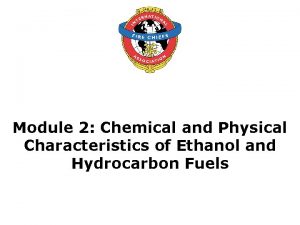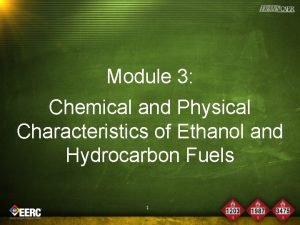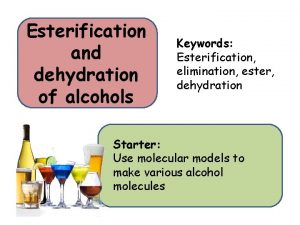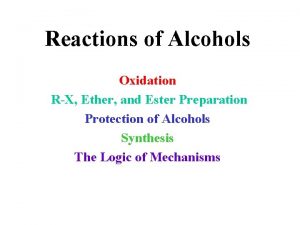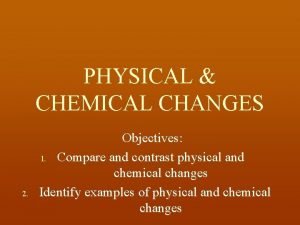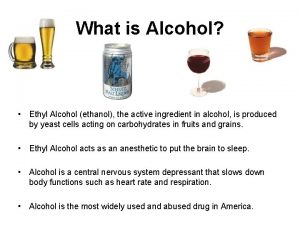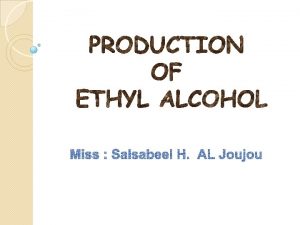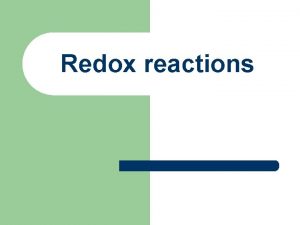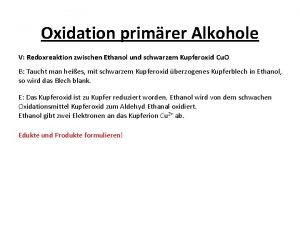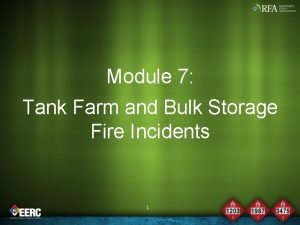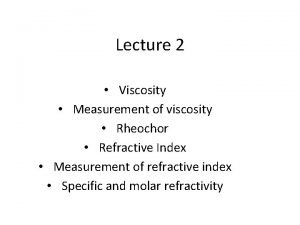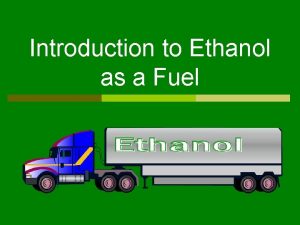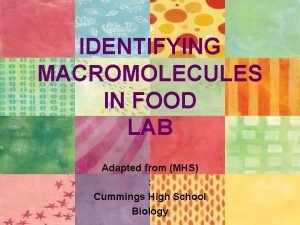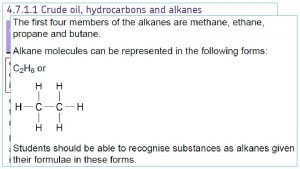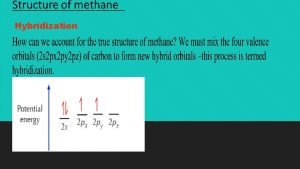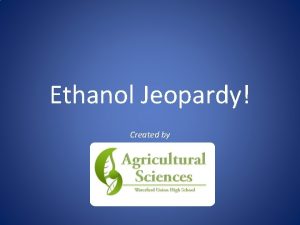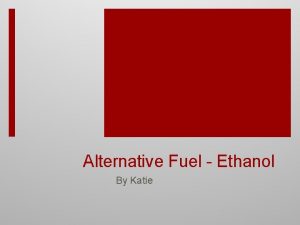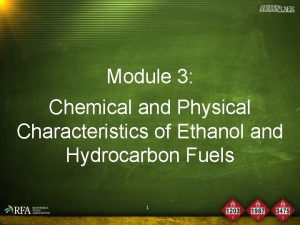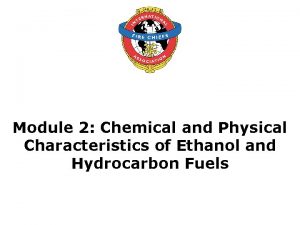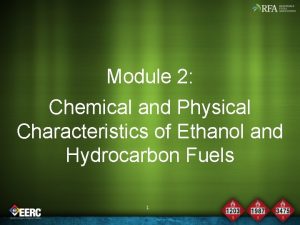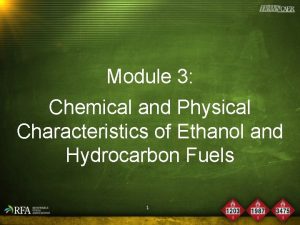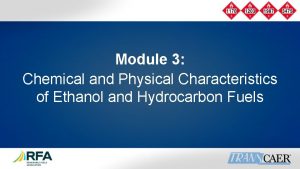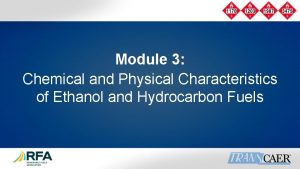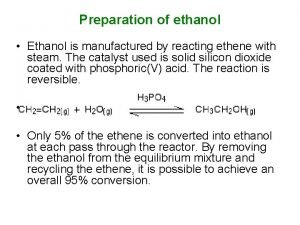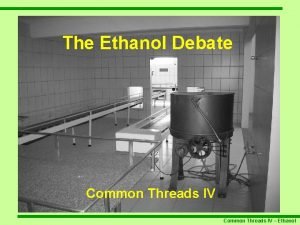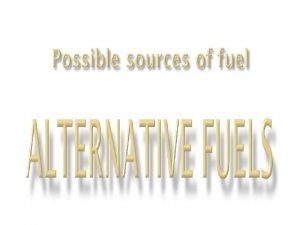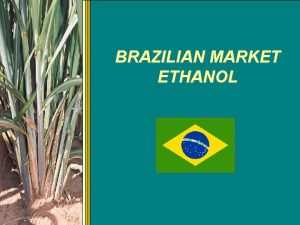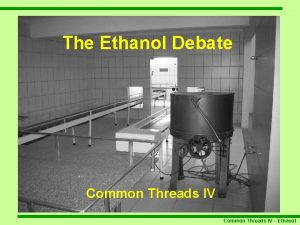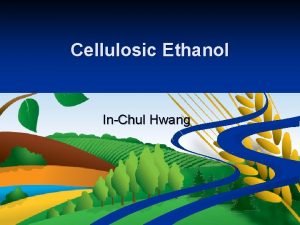Module 3 Chemical and Physical Characteristics of Ethanol



















- Slides: 19

Module 3: Chemical and Physical Characteristics of Ethanol and Hydrocarbon Fuels 1

Objective Upon the completion of this module, participants will be able to describe the chemical & physical differences between gasoline, ethanol & ethanolblended fuels. 2

Introduction • Characteristics of gasoline • Characteristics of ethanol • Conditions under which ethanol-blended fuels will retain chemical characteristics different than an all hydrocarbon fuel 3

Characteristics of Gasoline • Insoluble in water • Produced from crude oil • Harmful effects after long-term & high-level exposure • Smoke from burning gasoline is black & has toxic components • Significant hazard is flammability: – Fairly narrow range of flammability • 1. 4% - 7. 6% by volume in air 4

Gasoline Production David Parsons/NREL 5

Characteristics of Ethanol • Renewable fuel source produced by fermentation & distillation processes • Most common feedstock in U. S. is corn • Ethanol used with motor fuels must be denatured with 2% - 5% natural gasoline or similar hydrocarbon before transportation to bulk storage facilities • Denaturant has minimal effects on characteristics except for flash point – The addition of denaturant further depresses the flash point 6

Ethanol Production 7

Characteristics of Denatured Fuel Ethanol • Polar solvent • Miscible in water • Greatest hazard as motor fuel component is flammability – Wider flammable range than gasoline: • 3% - 19% by volume in air 8

Chemical Properties Comparison Property Gasoline Denatured Fuel Ethanol -450 F -50 F Auto Ignition Temp 530 - 8530 F 7090 F Specific Gravity 0. 72 – 0. 76 0. 79 3 -4 1. 5 8 - 15 psi ~3 psi Boiling Point 100 - 4000 F 165 - 1750 F Flammable Range 1. 4% - 7. 6% 3% - 19% Smoke Characteristics Black Slight Solubility Trace High Flash Point Vapor Density Vapor Pressure 9

Considerations for Ethanol Fires • In undenatured/ neat form, the flame & smoke are not easily visible • In denatured form, the flame is orange and there is minimal smoke but both are visible • Large amounts of water required to dilute ethanol to no longer support combustion – Will continue to burn at five parts water to one part ethanol (5: 1 ratio/ 500% dilution) 10

Invisible Flames - Ethanol Thermal imaging 11

Activity 3. 1: Comparison of Gasoline and Ethanol Purpose: – To allow participants to discuss the differences & similarities in the chemical & physical properties of ethanol & gasoline 12

Characteristics of Ethanol-Blended Fuels • Ethanol & gasoline are miscible, creating a homogeneous fuel blend • Water contamination of ethanol gasoline fuel blends may cause phase separation: – Phase separation will introduce a water layer in the bottom that consists of water & ethanol – All hydrocarbon gasoline will remain in the top layer 13

Characteristics of Ethanol-Blended Fuels Water contamination of ethanol gasoline fuel blends may cause phase separation: – Gasoline floating on layer of ethanol/ water solution – Resulting ethanol/ water solution still flammable 14

Characteristics of Ethanol-Blended Fuels Blending fuels alters physical & chemical characteristics of original fuels: – Visual difference of smoke & flame characteristics: • Higher content of ethanol, less visible black smoke content & orange flame production 15

Consideration for Ethanol. Blended Fuel Fires • Best practice is the use of alcohol resistant foam, AR-AFFF • When phase separation of ethanol & gasoline occurs: – Gasoline layer floating on top will burn first – Ethanol water layer will burn next, flames and smoke may be diminished 16

Activity 3. 2: Definitions • Purpose: – To allow participants to identify the definitions related to ethanol & ethanol-blended fuels 17

Worksheet 3. 2: Definitions • • • Ethanol Polar solvent Hydrocarbon Flash point Auto-ignition temperature • Specific gravity • Vapor pressure • Vapor density • Boiling point • Flammable range – Upper explosive limit (UEL) – Lower explosive limit (LEL) • Toxicity • Flammable liquid 18

Summary • Ethanol is a polar solvent, miscible with water, & flammable • Higher content of ethanol means less visible black smoke, & orange flame production • Best practice is the use of alcohol resistant foam – AR-AFFF 19
 Physical characteristics of ethanol
Physical characteristics of ethanol Characteristics of ethanol
Characteristics of ethanol Anoate
Anoate Oxidation of alcohol mechanism
Oxidation of alcohol mechanism C device module module 1
C device module module 1 Compare and contrast chemical and physical changes
Compare and contrast chemical and physical changes Rovee-collier
Rovee-collier Chapter 7 chemical formulas and chemical compounds test
Chapter 7 chemical formulas and chemical compounds test 7-1 practice problems chemistry answers
7-1 practice problems chemistry answers How much ethanol in alcohol
How much ethanol in alcohol Uses of ethanol
Uses of ethanol Test for fat
Test for fat Combustion of ethanal
Combustion of ethanal V
V Is ethanol bulk gaining or reducing
Is ethanol bulk gaining or reducing What is rheochor in chemistry
What is rheochor in chemistry Introduction of ethanol
Introduction of ethanol Macromolecule indicator tests
Macromolecule indicator tests Covalent bond
Covalent bond Hybridization of ethanol
Hybridization of ethanol
